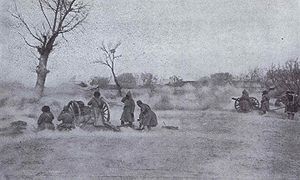| Battle of Mukden | |||||||||
|---|---|---|---|---|---|---|---|---|---|
| Part of the Russo-Japanese War | |||||||||
 Russian field gun firing during the battle of Mukden | |||||||||
| |||||||||
| Belligerents | |||||||||
|
|
| ||||||||
| Commanders and leaders | |||||||||
|
Ōyama Iwao Tatsumi Naofumi | Aleksey Kuropatkin | ||||||||
| Strength | |||||||||
|
270,250 troops
200 machine guns[2] | 292,000 troops[3] | ||||||||
| Casualties and losses | |||||||||
|
77,504 total: |
88,352 total: | ||||||||
The Battle of Mukden (奉天会戦, Hōten kaisen), one of the largest land battles to be fought before World War I and the last and the most decisive major land battle of the Russo-Japanese War,[7] was fought from 20 February to 10 March 1905 between Japan and Russia near Mukden in Manchuria. The city is now called Shenyang, the capital of Liaoning province in China.
Involving 610,000 combat participants and 164,000 combatant casualties, it was the largest modern-era battle fought prior to World War I, and possibly the largest battle in world history at that point.[8] The scale of the battle, particularly in the amount of ordnance being expended, was unprecedented in world history. The Japanese side alone fired 20.11 million rifle and machine gun rounds and 279,394 artillery shells in just over ten days of fighting (yet the Russians still fired more), matching the ammunition consumption of the German army in the entire 191-day Franco-Prussian War.[9] The battle was a decisive strategic victory for the Japanese and, coupled with their victory at the Battle of Tsushima four months later, proved critical in ending the war in their favor.
- ^ Tucker 2009, p. 1542: "Thus, the Battle of Mukden is not the decisive victory that the Japanese need."
- ^ Clodfelter 2017, p. 359.
- ^ "НЭБ - Национальная электронная библиотека".
- ^ Menning p.194
- ^ Martin p.207
- ^ Russian Main Military Medical Directorate (Glavnoe Voenno-Sanitarnoe Upravlenie) statistical report. 1914.
- ^ Palmer, Colton & Kramer 2007, p. 673
- ^ See List of battles by casualties.
- ^ John Steinberg (editor). "The Russo-Japanese War in Global Perspective: World War Zero." Volume II. Brill Academic Pub: May 2005. Pages 191-192.